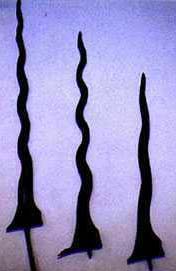|
| The Origins of Rajasa Dynasty |
| When the time came to collect the keris, Ken
Angrok found the smith still grinding the blade. In anger, he snatched hold of the
unfinished weapon and stabbed Mpu Gandring to death. As he lay dying, however, the smith
laid a curse on the kens, to the effect that it would be responsible not only for
the death of Ken Angrok himself, but for seven generations following. 
Ancient Keris,
traditional Javanese daggers, displayed at the Trowulan Museum
Returning to Tumapel, Ken Angrok then executed the next
part of his strategy, which involved handing the weapon over to a friend of his named Kebo
Hijo, a vain character who liked to show off in public. It was thus not long before every
one knew that Kebo Hijo possessed a new keris. And when Tunggul Ametung was
discovered, stabbed to death in his bed, everyone knew, too, who was responsible. So it
was that Kebo Hijo took the blame for the murder committed by Ken Arok, killed by the same
weapon at the vengeful hands of Tunggul Ametung's relatives.
The path was now clear for Ken Angrok to take over the
throne and claim his queen, apparently with the full support of the inhabitants of
Tumapel. He was crowned as Sri Rajasa Bathara Sang Amurwabhumi. Shortly after his
coronation, Ken Dedes gave birth to her son by Tunggul Ametung, who was named Anusapati. |
| At the time when Ken Angrok came to the
throne, Tumapel was still a minor kingdom, paying tribute to Java's principal ruler,
Kertajaya of Kediri. Kertajaya, however, was unpopular on account of his arrogance and
cruelty. He is said to have demanded obeisance from his priests, something which was
unheard of, and liked to demonstrate his supernatural powers by performing tricks, such as
embedding the base of his spear in the ground and sitting on its point! As time went by,
therefore, more and more of his followers went over to Tumapel. Yet Kertajaya remained
unmoved, claiming that he could only be defeated by Bhatara Guru himself (another name for
the god Shiwa). Countering this challenge, Ken Angrok, with the permission of his priests,
changed his name to Bhatara Guru and attacked Kediri in A.D. 1222. Kertajaya~s army was
annihilated and the defeated king fled to safety. While
both the Nagarakertagama and the Pararaton confirm the defeat of Kertajaya
in 1222, the two accounts differ concerning the events which followed. According to the Nagarakertagama,
the founder of the kingdom of Singosari died in 1227, after which his son, Anusanatha
(Anusapati) ruled over a peaceful land until his own death 20 years later. The Pararaton,
however, tells of a bloody power struggle which arose between the descendants of Ken
Angrok and Tunggul Ametung, apparently as a result of the curse of Mpu Gandring. Ken
Angrok is reported to have been stabbed in the back at the dinner table by his stepson,
Anusapati, in 1247, following the latter's discovery of the truth behind his father's
murder. Not long afterwards, Anusapati too fell victim to the keris, killed by
Tohjaya, a son of Ken Angrok by his concubine Ken Umang. Then, about two years later,
Tohjaya himself died in a rebellion incited by Rangga Wuni (Wishnuwardhana), the son of
Anusapati. With the coronation of' king Wishnuwardhana in around 1250, it is said that the
family feud was reconciled, a fact seemingly confirmed by historical data from the period. |
|
|
|
|
|
 |
|
 |
 |
 |
 |